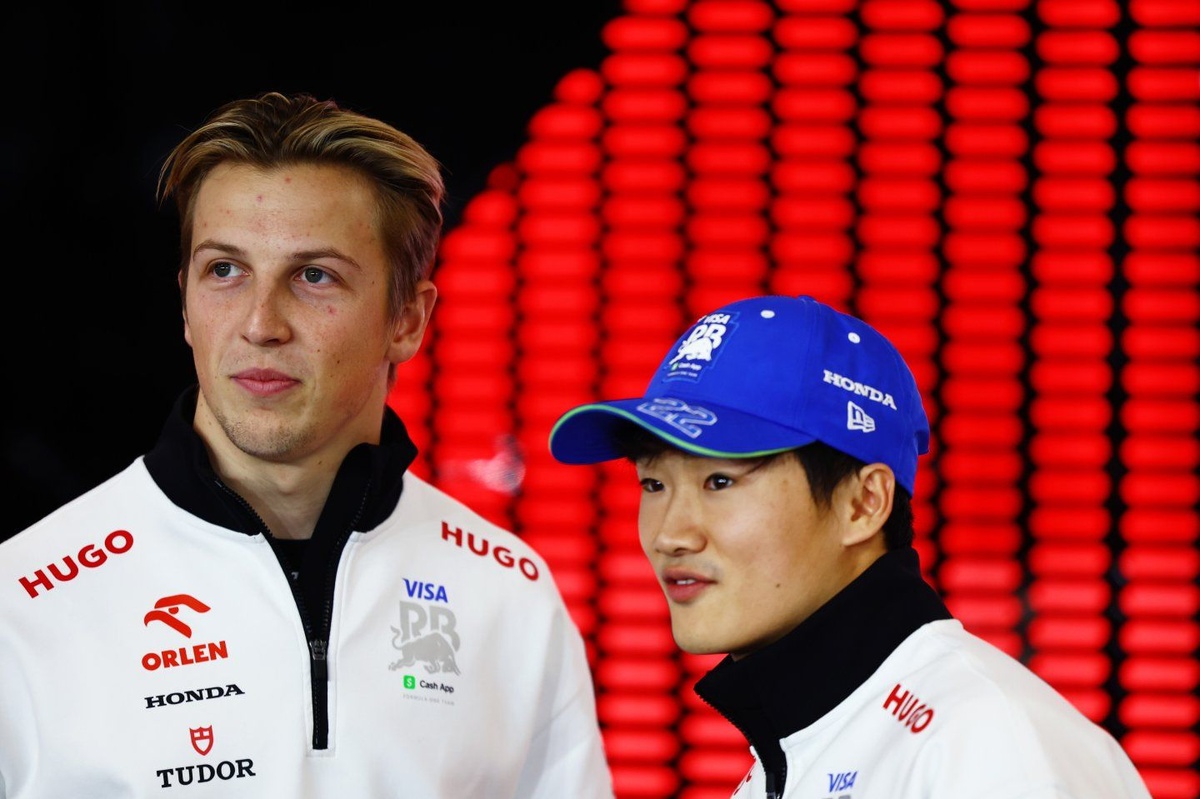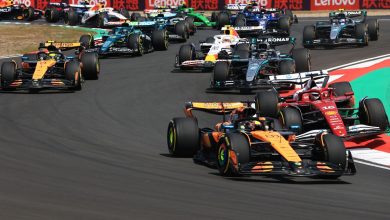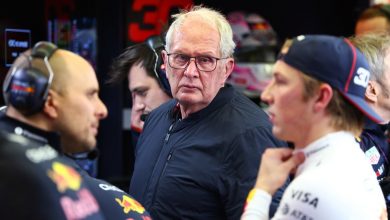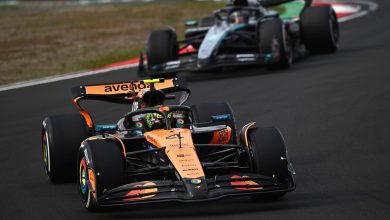The five reasons why Red Bull swapped Lawson and Tsunoda

It’s no secret that Red Bull is known for quick decisions when it comes to the driver market, but even by its standards, a change after just two race weekends is extreme. However, Red Bull has deemed it necessary to swap Liam Lawson with Yuki Tsunoda after just two weekends.
The decision is presented as a collective one, after a high-level meeting in Dubai on Tuesday with team principal Christian Horner, Red Bull advisor Helmut Marko and the Thai shareholders. Tsunoda gets his long-awaited shot at Red Bull after more than four years with the sister team, while Lawson is sent back to the junior outfit for now.
But what are the reasons for it, and why has the team acted ahead of the Japanese GP?
1. No signs of rapid improvement in the data
When Motorsport.com first broke the news about the looming driver swap on Sunday, Horner reacted in the Shanghai paddock saying the team would take a good look at the numbers: “We have plenty of data from the first two races and we’ll go through that in the upcoming days.” When asked if it was better to wait for Suzuka or Bahrain – tracks Lawson was familiar with – the team boss replied: “These guys get up to speed so quickly nowadays.” In other words, Red Bull didn’t see a reason to delay their decision any longer. It was a clear indication of what was to come.
It implies that the data Horner was talking about didn’t show many signs of quick improvements on the horizon. As the focus in car development has to shift toward 2026 at some point, Red Bull felt it couldn’t afford to wait. Lawson himself seemed aware of the ticking clock as well, saying on Saturday: “I just need more time in the car, but I know I don’t have it.” When Motorsport.com put those words to Marko, the Austrian replied: “He’s right.”
Paddock sources suggested that Lawson might have bought himself more time with a strong result in China, a points finish after starting from the pitlane, but that breakthrough performance never came. Red Bull saw no upward trend – however short the timeline may have been – and felt that waiting for the upcoming triple-header wouldn’t change things.

Liam Lawson, Red Bull Racing
Photo by: Sam Bloxham / Motorsport Images
Ironically, Lawson’s adaptation was named as one of the key reasons for his promotion last winter, along with his mental strengths. But in a top team and with an extremely difficult car to drive for everyone else than Max Verstappen, that adaption was too much to ask.
2. Honda’s influence behind the scenes
Another key factor in Tsunoda’s promotion is Honda’s role behind the scenes. The Japanese manufacturer is reportedly contributing around €10million and therefore sweetening the financial side of this move. It’s particularly relevant given the expensive replacement of Sergio Perez at the end of 2024. Honda’s backing has long been pivotal in Tsunoda’s Red Bull career, and now helps to tip the scales once again.
The timing of Honda’s backing is very interesting. Just weeks ago, the brand suggested that Tsunoda would need to prove himself independently with Honda’s future partnership with Aston Martin looming. But this opportunity was too good to pass up for all parties involved. Having a Japanese driver at the main team serves as an attractive way to conclude the Red Bull-Honda era in 2025 – assuming the 2026 regulations remain intact for now.
3. Tsunoda couldn’t have done more to prove himself
Beyond financial factors, Tsunoda himself deserves credit for this promotion. Once seen by the Red Bull bosses as a hot-headed driver – especially over team radio – the Japanese has matured to some extent. Following Pierre Gasly’s move to Alpine, Tsunoda had to step up as the team leader in Faenza, first outpacing Nyck de Vries, then going toe-to-toe with Daniel Ricciardo, whose fairytale return to Red Bull never materialised because of Tsunoda having the upper hand.
Tsunoda became more consistent during the 2024 season, and that trend has continued into this year. Marko’s comments in the Shanghai paddock were telling and already hinted on a driver change: “Yuki is in the form of his life” and “this is a different Yuki than the one we saw in previous years”.
Still, it’s a notable shift in a short time frame. Just four months ago, Red Bull looked at all the factors and data and opted for Lawson, seemingly discounting Tsunoda’s experience and technical feedback. Now, those aspects play a prominent role in the team’s press release. It underlines that things can change quickly in F1 – especially within the Red Bull camp.

Yuki Tsunoda, RB F1 Team
Photo by: Red Bull Content Pool
4. Red Bull has more to lose with Lawson than with Tsunoda
One of Horner’s most interesting remarks on Sunday was: “We have a responsibility towards Liam, and we’ll look at what’s best for him.” At first glance, these words suggested giving him more time and therefore more races at Red Bull. But in reality, the quotes were meant slightly differently: taking responsibility by pulling Lawson out of a high-pressure situation.
Yes, the demotion is a blow to Lawson’s career momentum and confidence. But leaving him to struggle alongside Verstappen week after week might’ve done more damage in the end.
Red Bull probably sees more long-term value in protecting Lawson than Tsunoda, whose future was already uncertain beyond 2025 given Honda’s departure. As Marko said in Bahrain: “If Yuki performs well, then there’s a future. If not, then maybe there is no more chance in F1 for him.”
If Tsunoda fails at Red Bull in the remainder of this season, the Milton Keynes-based team can say it gave him the chance and move on. It’s a lower-risk proposition both financially (thanks to Honda) and strategically. The PR risk of putting Tsunoda in the very difficult Red Bull car in front of his home fans in Japan is high, but even if it fails, Red Bull might consider it a manageable loss long term, especially knowing his future was uncertain beyond 2025 anyway. Lawson, meanwhile, could be rehabilitated in an easier car – a sentiment echoed by Verstappen in China: “I think if you give Liam the Racing Bulls car, he’ll be quicker. I really think that.”
5. The high-pressure situation Red Bull is in
Ultimately, this move speaks volumes about the urgency Red Bull feels and the situation it is in. In the press release to announce the swap, Horner was quoted: “We came into the 2025 season, with two ambitions, to retain the world drivers’ championship and to reclaim the world constructors’ title and this is a purely sporting decision.”
Whether Tsunoda’s promotion over Lawson helps achieve those goals remains to be seen, and most likely it won’t make much of a difference, but it reflects the urgency. There’s pressure on both the driver line up and the technical team. With focus inevitably turning to 2026 at some point, Red Bull knows that the first upgrades have to be spot-on. At the same time it can’t afford too many pointless weekends with the second car if it doesn’t want to lose sight of the constructors’ title already.
Red Bull feels it has to do “something”, and without many other options on the drivers’ front, “something” is giving Tsunoda’s his long-awaited chance at the main team. The real solution, however, needs to come from car development instead of driver changes – not least to prove Verstappen that Red Bull can still turn its fortunes around. If the constant struggles with its second seat have made anything clear, it is that the problem is more in the Red Bull car, not the drivers.
In this article
Ronald Vording
Formula 1
Helmut Marko
Max Verstappen
Liam Lawson
Yuki Tsunoda
Christian Horner
Red Bull Racing
Racing Bulls
Be the first to know and subscribe for real-time news email updates on these topics






